630-Wild Bee Conservation for Wild Blueberry Fields
Fact Sheet No. 630, UMaine Extension No. 2111
Prepared by Francis A. Drummond, Professor of Insect Ecology and Constance Stubbs, Assistant Scientist, the University of Maine Cooperative Extension, Orono, ME 04469. June 2003
Why Conserve Native or Wild Bees?
Wind and rain are important in the reproduction of many trees and grasses, but the majority of flowering plants in Maine are pollinated by animals. Small mammals and birds play a minor but important role as pollinators. However, it is the insects that are by far the most significant pollinators in Maine. The insects (jointed six-legged animals) are the most abundant group of terrestrial animals, usually numbering in the tens of millions in an acre of old field. In addition, the insects are the most diverse species of terrestrial animals. There are more species of insects in Maine landscapes than any other group of animals. More than one million species of insects have been scientifically described in the world and it is calculated that there may be in excess of 30 million species existing on the planet today. Not all insect species are pollinators. Some are predators of other insects, parasites of mammals and birds, consumers of green plants, and consumers of decaying organic matter. The most common insect pollinators are the bees, the moths and butterflies. Other insects of lesser importance are beetles, flies, wasps and hornets, ants, and thrips. The bees are the most important pollinators in Maine and have special adaptations that make them very efficient at moving pollen from one flower to another resulting in pollination and plant reproduction.
The Biodiversity of Bee Pollinators
There are about 17,000 species of bees that have been described worldwide; 4,000 species described in the U.S., and an estimated 270 species of bees occur in Maine. We have documented more than 40 bee species associated with lowbush blueberry in Maine. Many more species probably are associated with lowbush blueberry in Maine, for example, more than 60 species have been collected from lowbush blueberry in the two provinces of Nova Scotia and Quebec.
Bees are very diverse in their life histories, habits, size and form. Bees can be classified as native (endemic) or exotic (introduced). Most of the bee species in Maine landscapes are native. Native bees are exceptional pollinators of native plants like blueberry because native bees have been co-evolving with native plants for millions of years. This means that they are more likely to possess the morphological and behavioral adaptations necessary to pollinate the flowers than an introduced exotic bee. There are a few common exotic bees in Maine. The honey bee, Apis mellifera, is an exotic bee which was brought to the U.S. during early colonial times from Mediterranean Europe and Eurasia.
Bees can also be classified as solitary or social. A solitary bee is a species that raises its young individually. A single female adult bee, after mating, makes a nest, forages on her own, and provisions her young with food. Usually, adult solitary bees die after provisioning their young with food, never seeing the maturation of their young. The young develop into adult bees and overwinter to become the solitary provisioners the following spring. Social bees are considered more evolutionarily advanced than solitary bees. Social bees are usually characterized by group living.
The individuals in the group are usually closely related (a family), but not always (some of the less evolved social bees are communal societies). A single adult or group of adults are the primary reproductives. A division of labor usually exists such that other adults in the group that are not the primary reproductives forage for pollen and nectar, take on defensive roles for the colony, and feed the larvae. In addition, in the higher evolved Eusocial bees, such as the honey bees, there is often an overlap of generations such that a queen (mother) and various age worker bees (sterile daughters, granddaughters, and sometimes great-granddaughters) all form a family unit or colony together. There are several implications of being social. First, social bees tend to be active foraging throughout the spring, summer, and fall, while solitary bees are usually restricted to a 3-6 week period of activity, the length of an individual bee’s longevity in the field. Social bees tend to live in large colonies and so bee density may become very high in areas within a field. These life history characteristics have implications for the planting and management of floral resources. A continuous floral resource throughout the entire growing season is necessary to support communities of bees that are comprised of social bees and the solitary bee species that produce more than one generation a year.
Bees also vary in size. Small bees ( less than 1/4 inch in length) are common in Maine, but so are large bees (greater than 1 inch in length). Bee size can be (but is not always) correlated with the size and type of flowers that will be successfully visited. Bee size is also usually correlated with foraging distance and dispersal distance. Large bees, on average, will fly further to visit floral resources and search for nest sites than small bees. Most species of native bees in Maine landscapes are small and, given their limited flight capabilities, they are very susceptible to small-scale disturbances that result in loss of foraging and nesting habitat.
Bees nest in a variety of micro-habitats. Some bees, such as bumble bees, nest in old rodent burrows, stonewalls, and downed trees. Many solitary bees of the family Adrenidae (the sand bees or miner bees), nest in the soil by excavating tunnels and galleries to raise their young. The leafcutting bees, such as the Maine blueberry bee, nest in woodpecker holes, wood boring beetle galleries, and in the hollowed out pith of woody shrub twigs. Some mason bees, such as the blue orchard bee, nest in stone walls, hollowed twigs, and insect galleries in trees, but they seal the galleries or tunnels with mud collected in the vicinity of the nest site. Because bees usually forage close to their nests (foraging is a highly energy-intensive activity), optimal bee pasture is a landscape that has nesting sites that overlap with adjacent flower patches and water (streams and ponds).
Some Common Maine Bee Families and their Life Histories
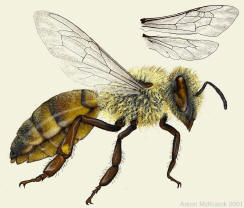
Family Apidae: This is one of the most diverse families of bees. Some members of the family Apidae are solitary, some are highly social, and some are social parasites of other bees. Some of the apid bees are very large. Two common apid bees in Maine are the honey bee and the bumble bee. A characteristic of the family Apidae is that the bees tend to be large, very hairy, and have hind legs that are equipped with dense hairs to hold pollen (pollen baskets).
Honeybee (see Figure 1): The honey bee is not native to Maine, although it has been in the U.S. since the 1600s when European colonists brought honey bees to the new world for the production of honey and wax. Honey bees are generalist bees and very efficient at extracting pollen and nectar from many different types of plants. The exception to this is blueberry. Honeybee workers are not adept at shaking blueberry poricidal anthers in order to obtain pollen. However, the sheer number of worker honey bees in a colony (30,000-75,000) overcomes any inefficiency in pollination. Honey bees are highly social (eusocial), each colony usually having a single long-lived queen (3-7 years) that can lay an average of 2,000 eggs per day. Honey bees collect more nectar and pollen than they need to feed their young on any one day. Thus, they are unique among most bees in that they can be managed for production of honey (concentrated nectar) pollen, wax, and resins (propolis). More information regarding the honey bee, especially as it relates to blueberry pollination can be found in Wild blueberry Bulletin # 629. Other references which cover basic bee biology, conservation, and honey bee management are included at the end of this fact sheet.
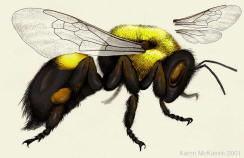
Bumble bee (see Figure 2): The bumble bee is a true native bee. The black and yellow or black and orange hairy large bees are quite unmistakable in appearance. There are several species (15) found in Maine. One species is managed for commercial pollination of blueberry (see Wild blueberry Fact Sheet No. 302). Bumble bees are superbly adapted to the cool northern spring climate in Maine and have physiological mechanisms that allow them to increase their body temperature well above air temperature resulting in their ability to incubate eggs and young and forage for pollen and nectar when air temperatures approach freezing. Bumble queens (reproductive females) are produced in the late summer and fall of the year, mate with males and then find protected overwintering sites (stonewalls, logs, rodent nests). Only the queens overwinter. In the spring, the queens emerge (usually April-May), search for a nest site and then initiate a colony by laying eggs, foraging for food, and feeding and caring for the young until the first young mature to adulthood as workers. Once workers (queen’s daughters) are present in the colony (early June), the queen becomes more involved in egg laying and the workers take over the duties of foraging, colony defense, and larval rearing. By the end of the summer (August – September) both male and female reproductives are produced, but only the queens overwinter, all workers perish. Colony numbers in Maine can increase to 100 workers, depending upon the species and location. Bumble bees are generalists, but they are remarkable in that they can learn to manipulate a broad range of flower types quite efficiently. Bumble bees possess an interesting behavior, “buzz pollination”.
Bumble bees will hold on to the petals of a flower with their legs and mouthparts, and vibrate their wing muscles which in turn vibrates the flower parts. This dislodges pollen from flowers that have sticky pollen or poricidal anthers. This behavior of buzz pollination makes bumble bees one of the most effective blueberry pollinators. Because bumble bees need most of the season to get to the point where the colony produced reproductives, a continuous floral resource is needed in areas where bumble bees are to prosper.
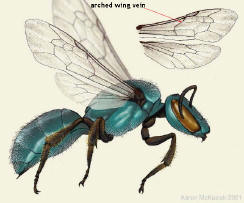
Family Halictidae (see Figure 3): This family has the common name of sweat bees. It is one of the most common families of bees found in the mid-summer in some parts of Maine if honey bees are ignored. Halictids include parasitic species, as well as, pollinators. Some of the most striking sweat bees are those that have a metallic green or blue-green sheen to them. Most halictids, however, are black or brown. These bees can usually be recognized by the arched first free segment of the medial wing vein (see Figure 3). The term “sweat bee” comes from their attraction to human perspiration or sweat. Often they will land on sweaty areas such as the arm, armpits, and in the fold between the forearm and upper arm. When they become trapped they will often sting, however, the sting is generally quite mild. Most halictids are very small bees. Many are solitary, but a few are communal, some are social, and some are even highly social. They usually nest in burrows in the soil, sometimes in rotting wood. Large numbers of these bees often nest close together and many bees may use the same passageway to the outside. These bees carry pollen on their hind legs (pollen baskets) and are most common during the dog days of summer. You can quite often find them visiting the flowers of plants belonging to the aster family.
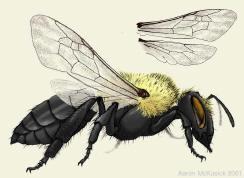
Family Andrenidae (see Figure 4): the sand bees or miner bees. The andrenids are small to medium size bees. Some andrenids resemble halictids in the field and are very difficult to tell apart. Andrenids are a very common native spring pollinator in Maine. All species are soil nesters and line their tunnels with a shiny waterproof secretion. Most andrenids have a solitary life history. These bees also carry their pollen on the hind legs by means of pollen baskets. Some species can be mistaken by an untrained eye as a small bumble bee due to the black and yellow coloration. Andrenids are usually not large and their abdomens are less fuzzy or hairy than the abdomens of bumble bees. Many of the species are black, but some have patterns and stripes on their abdomens. One genus of andrenids, Andrena, is perhaps the largest bee genera, having over one thousand species worldwide.
Family Megachilidae (see Figure 5): the leafcutting and mason bees. This family of bees is represented by medium size bees that are fairly stout or robust in shape. They differ from other families in that their members have only two submarginal wing cells on the front wing that are equal in length. A unique adaptation is for carrying pollen. The females of this family are characterized by a dense mat of hairs on the underside of their abdomen. This is called the scopa and is used to carry
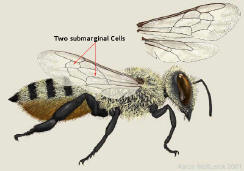
adhering pollen grains. When the scopa of these bees is fully covered with pollen, the females are easily recognized in the field. Their name is derived from the fact that many species use cut leaves to line their nest cells either in the soil or in hollow twigs. The majority of the species are solitary. Mason bees are leafcutting bees that use mud to either line or plug the end of their nest cells. The alfalfa leafcutting bee is an exotic species originally from the Mediterranean region of Europe and Asia. Although this species is considered a legume specialist and mass-reared by the millions in the western U.S. and Canada, it is also a very efficient pollinator of lowbush blueberry (see Wild Blueberry Fact Sheet, no. 300). Another common leafcutting bee found in Maine is the Maine blueberry bee. This leafcutting bee of the genus Osmia is associated with lowbush blueberry and its life history is well synchronized with blueberry bloom. The blue orchard bee is another species of the genus Osmia that is common to Maine. It is an important pollinator of blueberry and fruit trees in the spring. Both of these bees are a beautiful metallic blue, about the size of a house fly, and they readily accept wood nest blocks with drilled holes to nest in. Wild Blueberry Fact Sheet, No. 301 discusses the biology and conservation of this group of bees.
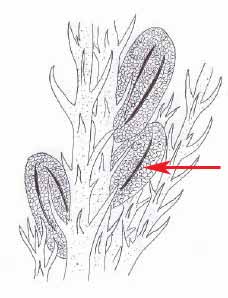
Importance of Pollination
Bees are the most important pollinators in lowbush blueberry and other agricultural landscapes in Maine. What makes bees so efficient as pollinators are that they collect pollen from flowers to bring back to their nests as a food source to feed their young. When collecting the pollen it becomes attached to special branched hairs located in dense mats all over the bee’s body (Figure 6). The bees groom most of this pollen on to pollen baskets or other pollen carrying devices on their legs or abdomen. However, much of it stays in the branched hairs and on their head and then is incidentally transferred to the female flower organ (stigma) receptive to pollen during subsequent flower visits.
Pollination is the foundation for sexual reproduction in most plants. After pollination (placement of pollen on the stigma) the fusion of the male germ cell (the pollen) with the female germ cell (the ovules) results in an embryo (the seed). These seeds are sometimes naked and sometimes surrounded by fruit as with lowbush blueberry. Figure 7 is a diagram of the pollination process. The placement of genetically compatible pollen on the stigma surface by wind or insects is the first step in the fertilization process. Chemical cues stimulate the pollen to produce a germ tube which grows down the female reproductive organ of the flower (style) to the ovary where the egg is located. The germ tube contacts the egg and allows fusion of male (generative cell) and female reproductive cells (fertilization). The process of insect pollination is very important since it maintains a diverse healthy plant population (plants originate from genetically diverse parents). In addition, insect pollination is a key ecological process since plant communities in Maine form the basis for animal food and habitat. Major changes in our ecosystems would occur if insect-mediated pollination was not a common occurrence.
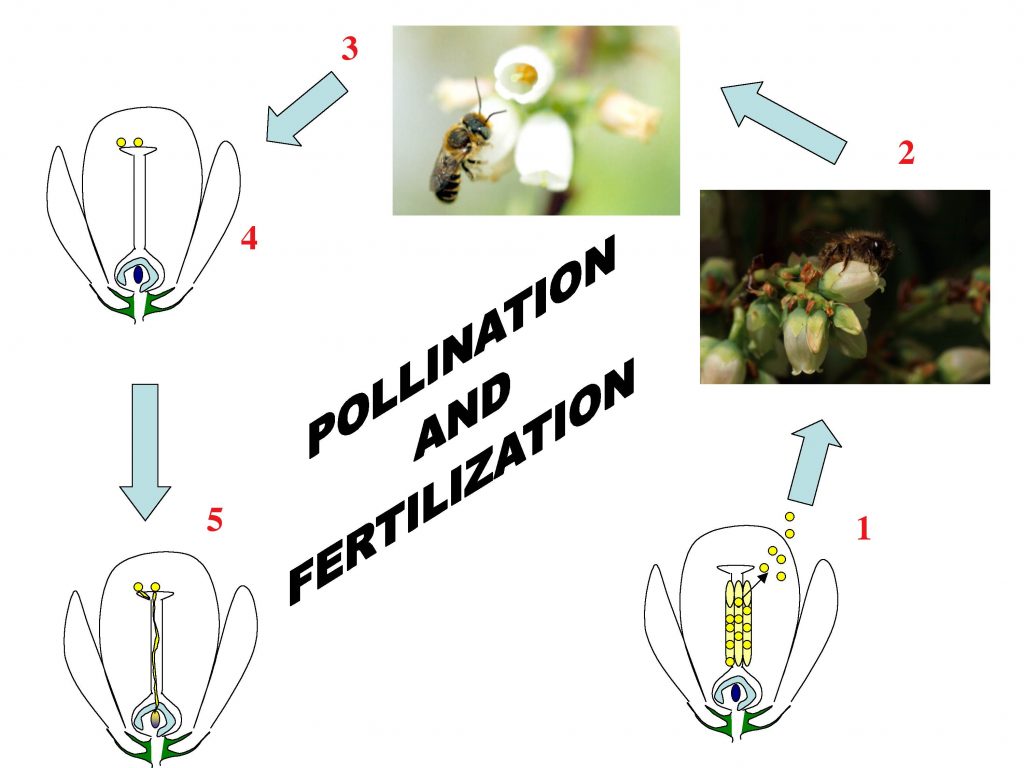
Pollination Crisis
There has been a drastic decline in insect pollinators throughout several areas of the world (on all continents except Antarctica) in the past few decades. Why has this been? Understanding the factors that have led to declines in insect pollinators should help us understand what we need to do in Maine to maintain healthy pollinator communities in our landscapes. The greatest threat to bee abundance and diversity has been the destruction of their habitat. This destruction is sometimes physical. For instance, the loss of a scrub/shrub habitat adjacent to a meadow might eliminate nesting sites for twig nesting bees and result in the elimination of their populations even though flowering plants in the meadow remain an abundant potential food supply. However, this destruction might also be due in part to chemical means. Use of insecticides toxic to pollinators can eliminate safe foraging zones during insect pest outbreaks or the very high efficacy of some herbicides might eliminate most flowering plants other than crop plants that bees need to visit for food. An important aspect of the resources that bees need is that generally optimum bee habitat is comprised of many partial or layered sites within an overall habitat that meets the needs of nesting, food, mating, water, and protected overwintering sites. Good bee habitat requires a diversity of geographical terrain to accommodate the diversity of bee species found in Maine. Overwintering sites may be in the soil in blueberry fields, cliff banks along hillsides and roads, along with stone walls throughout fields or along field edges, dead trees, and twigs of various deciduous shrubs. Nesting sites are generally similar to those sites that are selected by bees for overwintering. Mating sites may be at the nesting sites or on flowers and flowering trees and shrubs in and around blueberry fields. The main foraging areas for nectar and pollen will be in or adjacent to blueberry fields prior to and after bloom, especially along field edges and in meadows adjacent to blueberry fields. During bloom, much of the foraging will probably be associated with the flowering blueberry plants within the field.
Natural Factors Affecting Bee Survival
There are a number of factors that affect the survival and population size of native bees. In general, these factors can be broken down into two types: physical factors, often referred to as abiotic factors; and biological or biotic factors. Weather conditions are the primary physical factors that detrimentally affect native bee populations. The three most challenging weather conditions facing bees are conditions during their period of overwintering or hibernating, early spring temperatures and rainfall, and then late spring or summer drought or flood conditions. During most winters, snow cover insulates the ground, logs, rock walls, the sites that many bees choose for overwintering. Lack of snow cover in combination with high winds and low temperatures can result in high mortality of bees during the winter. This is also probably true for twig nesting bees that overwinter in stems or logs as pupae or adult bees. It is not uncommon in Maine, after a harsh winter, to find that many bee species emerging in the spring are at low numbers. Often harsh winters tend to negatively affect many species simultaneously. Early spring cold snaps can be especially detrimental to bees. Heavy frosts can result in the loss of flowering plants that are scarce resources, to begin with. In addition, cold wet weather can prevent many species from leaving the nest to forage. A day or two is most likely not too detrimental, but when a cold front becomes settled for 7-10 days, bees are more likely to succumb to biotic mortality factors (see below). Droughts are another factor that might play havoc on bee populations since plant growth and development are dependent upon adequate soil moisture. Drought can delay plant emergence or flowering time resulting in bees missing the occurrence of food and drought can also directly affect nectar and pollen production so that even though flowers are available, little or no food resources are available to the bees.
Of the factors that affect the reproduction and survival of native bee populations, the biotic factors are sometimes the easiest to detect. The biotic factors can be broken down into two groups: predators or parasites. Predators are animals that are usually larger than the prey (the bee). Predators kill the bee for food and usually need more than one bee to complete their development and reproduce. Black bears, birds (such as woodpeckers, bluebirds, and phoebes, to name a few), skunks, raccoons, foxes, mice, shrews, spiders, ambush bugs, stink bugs, bee wolf flies (specialized flies predaceous on bees) and robber flies are a few of the common predators of bees. Some predators such as birds, bears, mice, and skunks actively hunt and catch bees; while other predators such as spiders, and some of the predaceous bugs (ambush bugs and stink bugs) use a “sit and wait” or ambush strategy. They sit camouflaged in a flower and wait for an unsuspecting bee to come along, then pounce upon the bee. Some predators have a voracious appetite for bees and can have a detrimental impact on local bee populations, reducing them to almost zero. There is such a multitude of predators that attempting to prevent predators from killing native bees on your land is usually not possible and an ill-conceived plan since almost all of the predators that prey upon bees also prey upon other animals in the ecosystem including many noxious pest species. Therefore, while these predators keep bee populations in check they are also important in protecting plants from plant-feeding insects. In addition, many of these predators feed upon each other (birds eat bee wolves and robber flies) and so the overall impact of these predators is highly beneficial in providing balance across the landscape. Predators will usually not drive bee populations to extinction. This is because most bee predators are generalists, meaning that they feed on a variety of prey animals, not just bees. If a predator concentrated too much on a bee population, the prey’s numbers would fall and become more scarce and hence, the prey would become more difficult to catch. When a specific prey item becomes difficult to catch, a generalist predator will switch to a more profitable prey, thereby, allowing the bee population to recover. In special circumstances, it may be wise to protect bees from the destruction of predators. High concentrations of managed bees such as honey bees, bumble bees, alfalfa leafcutter bees, or Maine blueberry bees utilizing artificial nest blocks can be cued in on by predators such as birds or skunks. Protecting these managed bees by keeping predators away with electric fencing, lights, or noise making devices or pie plates suspended by strings above the bee nests may prevent loss of the bees.
Parasites are usually smaller than their bee hosts. Many are microorganisms that cause disease (such as viruses, protozoa, bacteria, and fungi), but a few are macroscopic such as solitary wasps, mites, and nematodes. Most parasites can complete their life cycle on a single bee. Some parasites have evolved an intimate relationship with their bee host such that they do not kill the host (although they may stress the host by taking needed nutrients). On the other hand, some parasites cause devastating disease that can eliminate entire bee populations. One interesting parasite is referred to as a social parasite. Social parasites such as cuckoo bees, sneak into a bee nest or colony of another bee species and lay their eggs. These eggs are cared for by the workers or queen bees of this other species and raised to adulthood, often at the expense of the progeny of the parasitized bee species. Similar to predators, most parasites are density dependent, meaning that their effect is usually greatest when bee populations are high (transmission of these parasites from bee host to bee host is enhanced at high densities). Therefore, parasites that are lethal to bees tend to result in the cycling of bee populations from high density to low density and back to high-density populations over a period of several years. Some parasites (such as the insect attacking fungus Beauveria bassiana, used as a least toxic approach to blueberry flea beetle control), like most predators, are generalists and can infect many species of bees in different families, but many parasites are specialists that only infect a particular species of bee. For example, American foulbrood disease of honey bees caused by a bacterium is no danger to native bee species.
What can you do to reduce the likelihood that parasites and disease-causing agents may lower the numbers of your native bees in a given year? There is no direct method for reducing this risk in non-managed bees. However, a general principle is that many parasites and diseases of insects such as bees cause a higher incidence of morbidity and mortality if the host insect is under stress (the same concept is the basis for disease prevention in humans). What can you do to reduce stress in bee populations? A few things that you can do is to:
- minimize exposure of bees to insecticides or other pesticides by limiting or eliminating their use on your landscape,
- provide bees access to abundant forage (pollen and nectar sources) throughout the entire spring, summer, and fall (this might mean conservation of existing flowering natural areas or planting bee forage (see discussion below),
- provide access to optimal soil and twig nesting sites by protecting south facing soil embankments and woody shrub thickets along the edge of fields, and
- maintain or plant windbreaks that will reduce energy requirements for foraging bees and provide natural snow drifts which will help to insulate bees overwintering underground.
Foods and Other Resources Bees Depend Upon
It is important to understand the material requirements of bees in order to maximize their conservation. Access to water, food, and sometimes oils, resins, leaves, and mud are essential for sustaining the basic metabolic processes of growth and development in bees and for the rearing of their young. As already mentioned, optimal nest sites, overwintering habitat, and mating sites are also critical to sustaining a strong population of pollinators. More discussion of managing for these attributes is provided in the last section of this fact sheet. Both adult and immature or larval food resources need to be considered for bee conservation. Bee bread, a mixture of pollen and nectar is often the primary food resource for native bee larvae. Nectar is the primary food source for adult bees. Adult bees primarily need food for flight energy. Some adult bees such as the bumble bees also eat nectar and burn its calories to produce heat in order to incubate eggs and young larvae in the early spring. The adult queen and worker bumble bees also heat up their flight muscles so that they can forage on flowers to collect more food when the temperatures are close to freezing in early spring. Most bees are generalists, but there are a few specialist bees that only visit one or a few species of flowers for all of their food resources. The Maine blueberry bee is an example of a native species that is floral constant, meaning that it tends to forage on a limited number of flowers (mostly blueberry) even though many species of flowers may be in bloom during its foraging period. A single flowering plant species that produces both copious amounts of nectar and pollen may not be adequate for maintaining a bee community in an area. First of all, not all pollen and nectar sources are equally nutritious. The nectar from some plant species has even been found to be toxic to certain bee species. In addition, some nectars are too thick to be imbibed by foraging bees, and some pollens do not contain the full complement of amino acids that some larval bees need to complete development, and floral structure needs to match the tongue length of a bee. Bees with short tongues have difficulty extracting nectar from the base of flowers with long tubular corollas, while some long-tongued bees have difficulty extracting nectar from the shallow flowers of some plants belonging to the Aster family. Pollen can be equally challenging for some bees to collect. For instance, blueberry flowers possess anthers that are termed poricidal. These anthers contain pollen inside the anther. The anthers have small holes at the terminal end and, when shaken, release the pollen. Not all bees acquire the behavior to shake the anthers to extract the pollen. Thus, it goes without saying that in order to maintain a bee community, it is necessary to maintain a diverse community of flowering plants.
Water is required for all life. Bees are no different. Most bees have short foraging distances (less than 1 mile) and so areas with abundant access to streams, rivers, and lakes will be more likely to support large bee communities. Land that is marginal for both flowering plants and water will usually not support populous bee communities. Bodies of water that have herbaceous vegetation and woody shrubs up to and into the edge of the water will facilitate bees landing near the water in order to drink. Bees are not good swimmers and so they need platforms to land on which are in contact with water.
Oils, resins, leaves, and mud are important to many species of bees. Some species of bees use plant manufactured oils and essences as perfumes to attract members of the opposite sex. Resins, leaves, and mud are used by various soil and twig-nesting bees to line and waterproof their galleries used for rearing of the young. While leaves are almost always abundant, some species of leafcutting bees are very selective as to the texture of leaf that they will utilize for nesting, thus justifying a conservation management philosophy of maintaining a high diversity of herbaceous and woody shrubs.
Blueberry Production Practices that Affect Bee Populations
Some of the most common production practices in lowbush blueberry can affect bee population numbers in a positive or negative way. Awareness of some of these impacts may help us manage native bees to our advantage.
Pruning a field will only result in grave circumstances in regards to bee populations if it is performed when bees are actively searching for nest sites (April and May) or when a few of the late season species (bumble bees) might be foraging for fall nectar sources. Therefore, it is important to prune fields well after heavy frosts have occurred, but well before bee emergence commences in the early spring. Most bees that overwinter in the soil are probably protected by burning from the soils ability to insulate bees from high temperatures, despite this a softer burn would be expected to be less stressful on bee populations than a hard burn. Mowing or burning is expected to aid many soil nesting bees because this production practice maintains open bee nesting beds and reduces the amount of vegetation cover between blueberry plants, a habitat preferred by many of the andrenid soil nesting bees. Fire lanes are important along the edges of blueberry fields since many of the twig nesting species overwinter at the blueberry field and scrub/shrub edge. Burning the shrubs in this interface zone may reduce the number of bees overwintering to the next spring.
Field size and the relative degree of isolation of a blueberry field to other fields may affect the ability of an area to support adequate bee populations. Our research has found that small fields often have more populous bee populations than large blueberry fields, although this is not always the case. Much of this has to do with the ratio of field edge (perimeter) habitat to field proper. Bees are creatures that exploit edge habitats for nesting and foraging. Therefore, the greater the interface between possible nesting sites and field edges possessing abundant flowering plants, the more likely bees will be able to persist in a habitat. The flowering edges surrounding fields are key for providing food resources both before and after blueberry bloom. Our research in cranberry bogs has shown that more than any other factor, the abundance of flowering plants associated with the edges of bogs adjacent to the forest periphery was related to maintaining high native bee populations. Planted windbreaks are a means of providing some of this edge structure in large blueberry fields. Windbreaks not only provide bee nesting sites for some twig nesting bees (especially if the windbreaks include deciduous plantings), but they also provide flowering plant edge habitats and may increase overwintering ability by providing winter protection from winds and areas where snow accumulates.
Isolation of fields is not considered ideal, although some isolated fields have high bee populations. In general, there is a strong relationship between habitat diversity and plant diversity, and the resulting bee abundance and diversity of the pollinator community. A patchwork of interconnected fields is more likely to provide bees access to a variety of resources that is a small isolated field that is maintained upon a single production cycle. An isolated field that is harvested every other year is no doubt a good situation for insect pest control, but bees may be stressed for food resources during the vegetative cycle unless there is abundant alternate flowering plant habitat along the perimeter of the field.
Irrigation is a production practice that is increasing. Irrigation can have temporary detrimental effects on pollination since bees tend not to visit wet flowers. However, there is probably little evidence that irrigation, per se, affects native bee populations except if field edge perimeters with abundant flowers receive irrigation water. This might ensure against lack of floral resources during the drier summer months. Water is very important for bees and irrigation water that condenses on pipes or leaks from main valves and wells should have benefit to bee populations.
There has been much speculation by scientists that honey bees compete with native bees for floral resources and by doing so lower native bee populations. There is no evidence that this happens in Maine. Although, after bloom, before honey bee hives are removed from blueberry fields, it is expected that competition for other flowers would be intense. It is our opinion that honey bees should be moved out from blueberry fields as soon as bloom is over, thus allowing native bees full access to the early summer flowering plants.
Pesticide use is probably the most potentially damaging blueberry production practice to native bees. We have shown that native population levels of Osmia mason bees are inversely related to the amount of insecticide that a blueberry field in Maine receives. The key to minimizing pesticide impacts is to reduce exposure of bees to toxic quantities of pesticide. Choice does exist (see below), and whenever possible, pesticides should be used that have relatively low bee toxicity. In general, insecticides are harder on bees than fungicides and herbicides, although the indirect effects of herbicides, elimination of alternate flowering plants, can not be overstated as a problem in some fields. Choice also involves the selection of an insecticide that has a short residual lifetime. A spring application of azinphos-methyl (Guthion®) or phosmet (Imidan®) with a residual of one week makes it difficult to avoid, negatively impacting the bee community. Drift is another issue that is paramount in understanding minimizing the impact of pesticides on bees. Exposure of flowers about field edges or bee nesting areas will likely have a negative impact on bees and so insecticides should only be applied when drift potential is minimum (low winds, no inversion layers). See Fact Sheet No. 303, Minimizing Off-target Deposition of Pesticide Applications for more information on how to minimize drift.
Bee Toxicity Ratings of Common Pesticides Used in Maine Wild Blueberry
The effect of pesticide applications on native bees is difficult at best to conclude upon. This is because most of the research has been conducted on the honey bee which can have different physiological and behavioral characteristics than many other species and also because flowering and weather conditions at the time of pesticide application may affect pesticide susceptibility in bees. It can be said that, in general, herbicides and fungicides have less of a direct detrimental impact than insecticides on bees. Fungicides can be repellents and of course. Herbicides can directly reduce alternative flowering plant communities, but their direct toxicity to bees is generally thought to be low. A table has been included below that ranks bee susceptibility (honey bee or where known smaller leafcutter or alkali bee susceptibility) to many of the common pesticides used in Maine Blueberries.
| Table 1. Ranking of bee susceptibility to common fungicides, herbicides, and insecticides*. | |||||
| FUNGICIDE | RANK | HERBICIDE | RANK | INSECTICIDE | RANK |
| Bravo, chlorathalonil | N | 2,4,-D | N | Asana (XLR), esfenvalerate | H (M) |
| Captan | N | Diuron, Karmex | N | Guthion, Sniper, azinphos-methyl | H |
| Orbit, propiconazole | N | Fusilade DX, fluazifop-P butyl | L | Bt formulations | N |
| Poast, sexthoxydim | N | Botanigard or Mycotrol, Beauveria bassiana | N-L | ||
| Roundup, glyphosate | N | Confirm, tebufenozide | N-L | ||
| Sulfosate | N | Cythion, malthion | H | ||
| Terbacil, Sinbar | N | Imidan, phosmet | H | ||
| Velpar, Pronone hexazinone | N | malathion (ULV) | M (H) | ||
| Sevin (XLR), carbaryl | H (M) | ||||
| Spintor, spinosad | M (L) | ||||
| *Key: H = highly toxic…should only be applied to plants NOT in bloom M = moderately toxic…only applied in evening when bees have stopped foraging L = low toxicity…only applied in evening to early morning before bees forage N = none to minor levels of toxicity |
|||||
Management Zones for Bee Conservation
So how do we design a bee conservation zone? In general, bees prefer to nest in warm sunny locations. Thus maintaining landscapes that are hospitable to bees requires land that maximizes southern exposed soils and field edges. Bees also prefer dry upland sandy soils, although access to water (vernal pools, streams, ponds) and mud is extremely important. Early to mid-field succession is to be encouraged (periodic mowing) such that bee zones contain a high diversity of herbaceous plants as well as woody shrubs and flowering trees. These plants will serve multiple roles, as windbreaks, floral resources, mating sites, and nest sites. Since many soil nesting bees prefer bare soils with little vegetative cover, periodic plowing or scouring of the soil surface can enhance a location’s attractiveness to bees. Planting of floral resources can also be attempted. A list of bee forage plants, both native and horticultural selections follow. The optimal strategy of planting is to select plants that bloom before and then after the main blueberry bloom (or crop of interest) but won’t pull bees off of the crop during pollination. Stubbs et al. (1992) compiled a long list of native plants utilized by bees for either pollen or nectar (see reference citation at end of this bulletin). Here we have compiled a shorter list of some of the important floral resources in Maine for bees.
| Table 2. Some flowering plants that are good pollen and nectar resources for bees in Maine. | |||
| SPRING | EARLY SUMMER | MID-SUMMER | LATE SUMMER-EARLY FALL |
| alder | alfalfa | bee balm | asters |
| apple | annise hyssop | borage | autumn dandelion |
| blueberry | azalea | Echinacea | chickory |
| cherry – black, choke | blackberry | fireweed | goldenrods |
| columbine | chives | meadow sweet | meadow sweet |
| crocus | hawthorn | mullein | oregano |
| dandelion | honeysuckle | red clover | ragweed |
| lilac | locust | roses | yarrow |
| maple | mints | St. John’s wort | |
| oak | raspberry | sweet clover | |
| wild strawberry | sheep’s laurel | thistle | |
| willow | white clover | viburnum | |
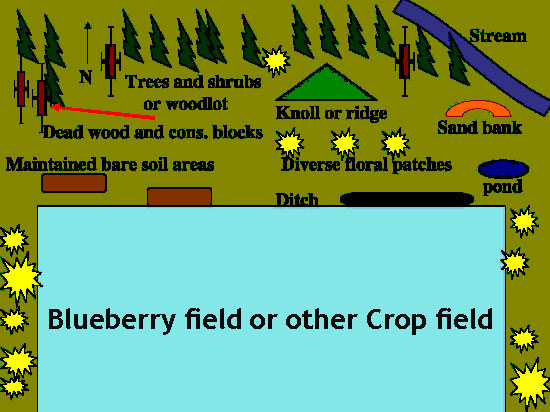
Sustainable landscapes for bees can be referred to as bee pasture. In recognizing good bee pasture or in attempting to design and manage for good bee pasture, a few basic concepts should be considered. As previously mentioned, bees need nest sites, overwintering sites and protection from cold north winds, water, protection from pesticides, especially insecticides, continuous pollen and nectar resources, and mating sites (usually flowers but can also be shrubs), and hummocks and hills on the landscape). The above illustration depicts a hypothetical example of a bee pasture which has these elements incorporated into it.
Postscript
Bees are fascinating animals and they are a key species in maintaining the functioning of both natural and managed agricultural landscapes. Preservation of their diversity and numbers will guarantee sustainable agricultural systems as well as healthy ecosystems for future generations. There is much you can do to provide good habitat for native bees. First, you can educate yourself about the multitude of bee species, families, their life histories and requirements for survival. You can also attempt to use pest management tactics that minimize detrimental effects on bees. Also, modest effort into providing landscapes that offer access to water and food (flowering plants), nesting, mating, and overwintering sites can go a long way to increasing the likelihood that survival will be increased in the light of all of the other factors that depress their numbers, such as extreme weather conditions and natural predators and parasites.
Further Reading
Further reading on bee conservation can be found in the following books at your library.
Bosch, J. and W. Kemp. 2001. How to manage the blue orchard bee. Sustain. Agric. Network, National Agric. Library. Beltsville, MD. 88 pp.
Buchmann, S.L. and G.P. Nabhan. 1996. The Forgotten Pollinators. Island Press, Washington, D.C.
Delaplane, K.S. and D. F. Mayer. 2000. Crop Pollination by Bees. CABI Publishing, Cambridge. 344 pp.
Kearns, C.A. and J.D. Thompson. 2001. The natural history of bumble bees. University Press of Colorado. Boulder, CO.
Matheson, A., Buchmann, S.L., O’Toole, C., Westrich, P., and I.H. Williams (eds.). 1996. The Conservation of Bees. Academic Press, San Diego. 254 pp.
O’Toole, C. and A. Raw. 1991. Bees of the World. Facts on File. NYC, NY.
Stubbs, C.S., H.A. Jacobson, E.A. Osgood, and F.A. Drummond. 1992. Alternative forage plants for native (wild) bees associated with lowbush blueberry, Vaccinium spp., in Maine. Maine Agri. Exp. St. Tech. Bull. 148, 54 pp.
Stubbs, C.S. and F.A. Drummond (eds.). 2001. Bees and Crop Pollination – Crisis, Crossroads, Conservation. Entomological Society of America, Maryland. 156 pp.
Acknowledgment
We would like to thank Aaron McKusick, an art student at the University of Maine, for his artistic renderings of some of the common bees associated with blueberry in Maine and much thanks to Dr. David Yarborough for providing insightful comments and editorial comments.
Information in this publication is provided purely for educational purposes. No responsibility is assumed for any problems associated with the use of products or services mentioned. No endorsement of products or companies is intended, nor is criticism of unnamed products or companies implied.
© 2009
Call 800.287.0274 (in Maine), or 207.581.3188, for information on publications and program offerings from University of Maine Cooperative Extension, or visit extension.umaine.edu.
The University of Maine is an EEO/AA employer, and does not discriminate on the grounds of race, color, religion, sex, sexual orientation, transgender status, gender expression, national origin, citizenship status, age, disability, genetic information or veteran’s status in employment, education, and all other programs and activities. The following person has been designated to handle inquiries regarding non-discrimination policies: Director of Equal Opportunity, 101 Boudreau Hall, University of Maine, Orono, ME 04469-5754, 207.581.1226, TTY 711 (Maine Relay System).
